PARP抑制剂作为抗肿瘤药物的潜力及分子设计展望
IF 6.8
1区 医学
Q1 CHEMISTRY, MEDICINAL
引用次数: 0
摘要
PARP (poly-ADP核糖聚合酶)在肿瘤治疗中受到广泛关注。研究表明,PARP在DNA损伤修复中起着至关重要的作用,并已成为药物设计的热门靶点。基于“合成致死性”的机制,多种PARPis (PARP抑制剂)被用于治疗BRCA缺陷肿瘤。例如,批准的parpi在癌症治疗中显示出巨大的潜力,特别是在乳腺癌和与BRCA1/BRCA2缺陷相关的癌症中。然而,PARP抑制剂在不同癌症中的临床疗效和安全性仍然是不容忽视的问题。parpi的设计旨在消除其阻力,扩大其应用范围。设计选择性PARP-1抑制剂也是一种潜在的策略。蛋白质水解靶向嵌合体(Proteolysis Targeting Chimeras)降解PARP已成为一种潜在的新型癌症治疗策略。本文章由计算机程序翻译,如有差异,请以英文原文为准。

The Potential of PARP Inhibitors as Antitumor Drugs and the Perspective of Molecular Design
PARP (poly-ADP ribose polymerase) has received widespread attention in cancer treatment. Research has shown that PARP plays a crucial role in DNA damage repair and has become a popular target for drug design. Based on the mechanism of “synthetic lethality”, multiple PARPis (PARP inhibitors) have been launched for the treatment of BRCA deficient tumors. For example, the approved PARPis have shown significant potential in cancer treatment, particularly in breast cancer and cancers associated with BRCA1/BRCA2 deficiencies. However, the clinical efficacy and safety of PARP inhibitors in different cancers remain issues that cannot be overlooked. The design of PARPis aims to eliminate their resistance and broaden their application scope. Designing selective PARP-1 inhibitors is also a potential strategy. PROTACs (Proteolysis Targeting Chimeras) to degrade PARP have become a potential novel cancer treatment strategy.
求助全文
通过发布文献求助,成功后即可免费获取论文全文。
去求助
来源期刊

Journal of Medicinal Chemistry
医学-医药化学
CiteScore
4.00
自引率
11.00%
发文量
804
审稿时长
1.9 months
期刊介绍:
The Journal of Medicinal Chemistry is a prestigious biweekly peer-reviewed publication that focuses on the multifaceted field of medicinal chemistry. Since its inception in 1959 as the Journal of Medicinal and Pharmaceutical Chemistry, it has evolved to become a cornerstone in the dissemination of research findings related to the design, synthesis, and development of therapeutic agents.
The Journal of Medicinal Chemistry is recognized for its significant impact in the scientific community, as evidenced by its 2022 impact factor of 7.3. This metric reflects the journal's influence and the importance of its content in shaping the future of drug discovery and development. The journal serves as a vital resource for chemists, pharmacologists, and other researchers interested in the molecular mechanisms of drug action and the optimization of therapeutic compounds.
 求助内容:
求助内容: 应助结果提醒方式:
应助结果提醒方式:


